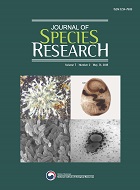A report of 18 unrecorded prokaryotic species isolated from the feces of an Oriental stork (Ciconia boyciana), and from the intestinal tracts of a cobitid fish (Kichulchoia multifasciata) and a Korean splendid dace (Coreoleuciscus splendidus)
한정은 (경희대학교)
김필수 (경희대학교)
배진우 (경희대학교)
- 다운로드 수
- 조회수
Abstract
The animal gut is filled with highly diverse microbes associated with host metabolism, physiology, and pathology. However, numerous animal gut microbes have not been cultured or reported. We isolated various bacterial species using culture-dependent approaches during a comprehensive investigation of endangered endemic vertebrate species in the Republic of Korea. A total of 18 unrecorded bacterial species were isolated from the feces of an Oriental stork (Ciconia boyciana), and from the intestinal tracts of a cobitid fish (Kichulchoia multifasciata) and a Korean splendid dace (Coreoleuciscus splendidus). Based on a phylogenetic analysis of 16S rRNA gene sequences, we discovered species belonging to the phyla Actinobacteria (eight species), Firmicutes (seven species), Proteobacteria (two species), and Bacteroidetes (one species). Based on their high 16S rRNA gene sequence similarities (>98.7%) and formation of monophyletic clades with type species, each species was classified into an independent and predefined bacterial species. Gram-stain reaction, colony and cell morphology, basic biochemical characteristics, isolation source, and NIBR IDs for each species are described in the species description section.
- keywords
- 16S rRNA gene sequences, phylogenetic analysis, unreported bacterial species
참고문헌
Cani, P.D. 2017. Gut microbiota-at the intersection of everything? Nature Reviews Gastroenterology & Hepatology 14:321.
Choe, S., D. Lee, H. Park, H.-K. Jeon, Y. Lee, K.-J. Na, S.-R. Park and K.S. Eom. 2016. A case of chaunocephalosis by Chaunocephalus ferox (Digenea: Echinostomatidae)in an oriental white stork, Ciconia boyciana, in Korea. The Korean Journal of Parasitology 54:659.
Dave, M., P.D. Higgins, S. Middha and K.P. Rioux. 2012. The human gut microbiome: current knowledge, challenges, and future directions. Translational Research 160:246-257.
Felsenstein, J. 1981. Evolutionary trees from DNA sequences:a maximum likelihood approach. Journal of Molecular Evolution 17:368-376.
Fodor, A.A., T.Z. DeSantis, K.M. Wylie, J.H. Badger, Y. Ye, T. Hepburn, P. Hu, E. Sodergren, K. Liolios and H. Huot-Creasy. 2012. The “most wanted” taxa from the human microbiome for whole genome sequencing. PLoS One 7:e41294.
Hooper, L.V. and J.I. Gordon. 2001. Commensal host-bacterial relationships in the gut. Science 292:1115-1118.
Kim, J. and J. Park. 2017. Morphological characteristics of visual cells in the endemic Korean loach Kichulchoia multifasciata (Pisces; Cobitidae) by microscopy. Folia Morphologica 76:186-190.
Kluge, A.G. and J.S. Farris. 1969. Quantitative phyletics and the evolution of anurans. Systematic Biology 18:1-32.
Kumar, S., G. Stecher and K. Tamura. 2016. MEGA7: molecular evolutionary genetics analysis version 7.0 for bigger datasets. Molecular Biology and Evolution 33:1870-1874.
Lane, D. 1991. 16S/23S rRNA sequencing. In ‘Nucleic acid techniques in bacterial systematics’. (Eds E Stackebrandt, M Goodfellow) pp. 115-175. (John Wiley and Sons: Chichester, UK).
Lee, S.-Y., W. Kang, P.S. Kim, H.S. Kim, H. Sung, N.-R. Shin, T.W. Whon, J.-H. Yun, J.-Y. Lee and J.-Y. Lee. 2019. Undibacterium piscinae sp. nov., isolated from Korean shiner intestine. International Journal of Systematic and Evolutionary Microbiology 69:3148-3154.
Mesbah, M., U. Premachandran and W.B. Whitman. 1989. Precise measurement of the G+C content of deoxyribonucleic acid by high-performance liquid chromatography. International Journal of Systematic and Evolutionary Microbiology 39:159-167.
Nayfach, S., Z.J. Shi, R. Seshadri, K.S. Pollard and N.C. Kyrpides. 2019. New insights from uncultivated genomes of the global human gut microbiome. Nature 568:505.
O’Hara, A.M. and F. Shanahan. 2006. The gut flora as a forgotten organ. EMBO Reports 7:688-693.
Round, J.L. and S.K. Mazmanian. 2009. The gut microbiota shapes intestinal immune responses during health and disease. Nature Reviews Immunology 9:313.
Saitou, N. and M. Nei. 1987. The neighbor-joining method:a new method for reconstructing phylogenetic trees. Molecular Biology and Evolution 4:406-425.
Shigematsu, T., M. Hayashi, I. Kikuchi, S. Ueno, H. Masaki and T. Fujii. 2009. A culture-dependent bacterial community structure analysis based on liquid cultivation and its application to a marine environment. FEMS Microbiology Letters 293:240-247.
Thompson, J.D., D.G. Higgins and T.J. Gibson. 1994. CLUSTAL W: improving the sensitivity of progressive multiple sequence alignment through sequence weighting, position-specific gap penalties and weight matrix choice. Nucleic Acids Research 22:4673-4680.
Tremaroli, V. and F. Bäckhed. 2012. Functional interactions between the gut microbiota and host metabolism. Nature 489:242-249.
Wu, S.-C., Z.-S. Cao, K.-M. Chang and J.-L. Juang. 2017. Intestinal microbial dysbiosis aggravates the progression of Alzheimer’s disease in Drosophila. Nature Communications 8:24.
Yoon, S.-H., S.-M. Ha, S. Kwon, J. Lim, Y. Kim, H. Seo and J. Chun. 2017. Introducing EzBioCloud: a taxonomically united database of 16S rRNA gene sequences and whole-genome assemblies. International Journal of systematic and Evolutionary Microbiology 67:1613.
- 다운로드 수
- 조회수
- 0KCI 피인용수
- 0WOS 피인용수


